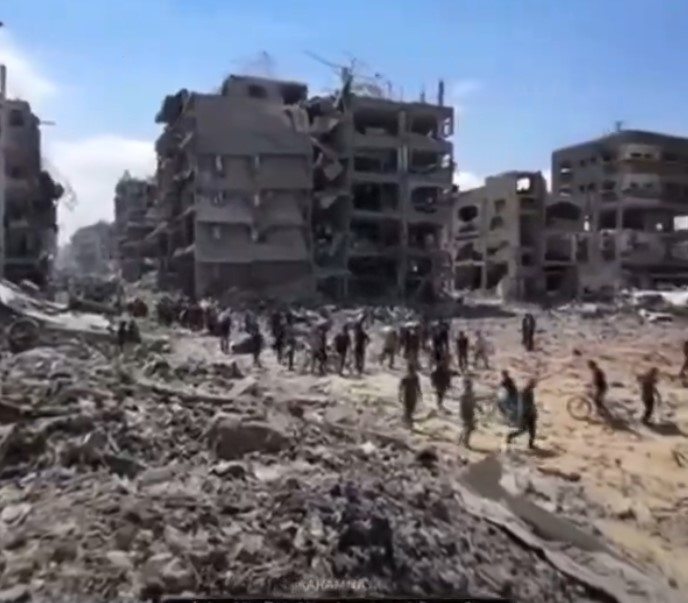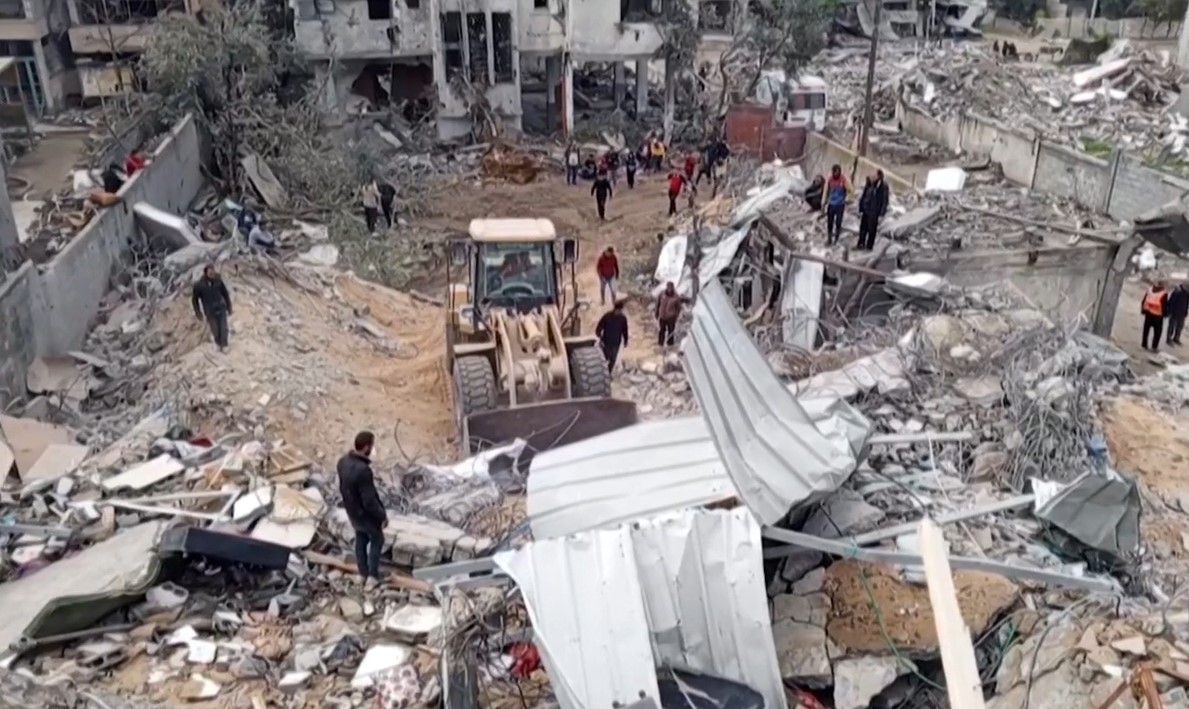[Part ONE]
A ceasefire finally took effect in Gaza last Sunday, although it had been postponed for three hours, during which time nineteen more Palestinians were killed by Israeli bombing. That fact alone shows the huge military imbalance between Israel, the Middle East’s only super-power, and the Palestinians of Gaza who have suffered a horrendous collective punishment for the Hamas incursion into Israel on October 7, 2023.
The presence of the Israeli military in Gaza hangs like a dark shadow over Gaza. In the three days between the announcement of an agreement and the ceasefire coming into effect, Israel did not hesitate for one moment to kill more children. Al Jazeera even reported yet another child killed by an Israeli sniper a day after the ceasefire began.
Although the ceasefire is therefore a welcome relief to the population, that relief is tinged with fear about the future: it is a temporary truce, for six weeks in the first instance, and serious questions remain in the longer term about the prospects for Palestinian rights and freedoms. The worst of everyone’s nightmares – a resumption of Israeli bombing after that period – is by no means ruled out.
The viciousness of the Israeli government towards Palestinians can be seen in the spiteful and violent way in which they have actively suppressed any displays of joy or celebration over the release of Palestinian hostages. The Israeli media – ably supported by the mainstream media in the west – have celebrated every one of the three Israeli hostages released so far. And these people have names and histories.
But the Palestinian prisoners in Israel – and they too are hostages held without trial or any judicial process – are nameless and faceless. Moreover, on the West Bank, Israeli state forces have raided homes of their families even as they were released. The Guardian reported, “The Israel Prison Service said on Friday that it would take measures to prevent any ‘public displays of joy’ by families of Palestinian prisoners released in the deal”.
It is inevitable that the population of Gaza will experience an outpouring of relief. They have suffered a bombardment of Second World War proportions in the past fifteen months. The BBC, disgracefully following a pro-Israeli line throughout, refer to this as a “conflict” but in the whole history of modern warfare there has never been a more one-sided conflict.
What Gazans fear is that, as an article in the Financial Times noted, “a new bleeding will begin.” One can only stand back in awe at the sheer grit and determination of ordinary Palestinians who, despite everything, are trying to go back to the rubble that was once their homes. “People are very happy,” a mother of four young children was quoted in the FT. Although she had lost her husband, mother, brother and two uncles in the war, she said, “I [too] am optimistic despite my pain.”
“We lost everything”, another woman said, “including loved ones, but it is time this torrent of blood has been stemmed…My house in Gaza City was bombed and destroyed but I am content to go back and live in its ruins. I can’t believe we will finally go home. I have been displaced 14 times.”
Unbelieveable devastation in Gaza
The devastation in Gaza has been unbelievable. Even an august pro-capitalist newspaper like the Financial Times recently carried an article on “how Israel erased a town of 200,000”. The town in question was Jabalia in the north, which also gave its name to a nearby refugee camp. Jabalia was once a thriving, vibrant community, but by November, one of the former residents told the Financial Times, “there was nothing to see — nothing left, just ruins and rubble” Referring to his father he added, “his entire life has been erased. All that remains are his memories.”

Already, in the lull after the bombing, Hamas has reported that food distribution is managed properly and that efforts are being made to clear the rubble, at least across roads and key areas. As anticipated, hundreds of bodies are being discovered to have been lying under rubble for weeks or months.
The death toll, of nearly 47,000, 70% of whom, according to the United Nations, are women and children is almost certainly much higher than the offical number. According to an article in the authoritative medical journal, The Lancet, (January 15, 2025), the Hamas figures seriously underestimate the real casualty numbers.
The researchers looked at deaths between October 7 2023 and the end of June last year, and they estimated “64,260 deaths…due to traumatic injury” during that period. The Gaza Ministry of Health (MoH), the article therefore suggests, “underestimate mortality by 41%”. Moreover, the collection of data by the MoH has been heavily disrupted by destruction and, as is now being revealed, possibly thousands are still reported as missing and may be lying under rubble. All told, the article suggests, the speculation is that the total number of deaths “could push all-cause excess mortality to 186,000”.
This is an astonishing figure. In proportion to the population of Gaza, this number – overwhelmingly non-combatants – is more than the total casualties in Britain of two world wars. If the Gaza death toll was multiplied to be in proportion to the UK population, it would run into millions of dead – as many as 5 million, if the speculation in the Lancet is correct.
It is worthwhile considering why this ceasefire was agreed by Israel, when it is essentially the same as the deal proposed and rejected by Netanyahu last summer. Part of the reason is the worldwide opposition to Israeli policy in Gaza. There may have been some initial sympathy after October 7, when Hamas launched its dramatic and unexpected attack on Israel, killing over a thousand Israelis and taking over two hundred hostages – although anyone with any knowledge of Gaza understood that it was like an open prison, kept under siege and under rationimg by Israel for fifteen years.
But it quickly became clear after October 7, that the Hamas raid had become a pretext, for the most right-wing government in Israeli history, to launch a vicious and murderous collective punishment on the population of Gaza. With the exception of the mainstream politicians and press in the west, there has been a world-wide surge of horror at the Israeli actions in Gaza.
Adding up all the demonstrations, often week after week, in all the cities of the world, the movement in support of Palestinian rights has become the largest global political movement in modern history. Israel has become a pariah state.
Gideon Rachman complained in the Financial Times (January 16), that as a result of its policy in Gaza, “Israel has suffered enormous reputational damage”. That is putting it mildly. Rachman continued, “Young people — even in the US — are now much more hostile to the country. A Pew survey in April concluded that: ‘Younger Americans are more likely to sympathise with the Palestinian people than the Israeli people.’ A third of adults under 30 said their sympathies lay either entirely or mostly with the Palestinian people, compared with 14 per cent siding with Israel”.
Workers across the world outraged by Israeli onslaught
This is the underlying reason for Israel and Netanyahu agreeing to a ceasefire now. Overwhelmingly, workers and youth across the world have marched, rallied and demonstrated in support of Palestine. Even in Israel there are some who acknowledge the “apartheid” character of Israeli policy and talk of “genocide” in Gaza.
The ceasefire is only confirmed for 42 days, ie six weeks, during which time there will be an exchange of hostages, some of those held in Israeli prisons for some of those held by Hamas since October 7. By the sixteenth day of the ceasefire, negotiations are supposed to begin to find a more permanent solution Beyond that, there is a gaping unknown.
History will judge unequivocally that the bombing and the deliberate starvation of the Gaza population was an attempted genocide. The crime of the Labour leadership, to have been complicit in this, easily matches that of his predecessor, Tony Blair, who manufactured a fake pretext to help the USA invade Iraq in 2003.
This ceasefire, as welcome as it is for the moment, is far from offering an end to the immediate crisis, let alone a solution to the needs of the Palestinian people. There is not even an agreement about what a final ‘settlement’ of the Palestinian question would look like.
There are still important factors that will be brought to bear in the coming weeks: the right wing of the Israeli government, which openly clamours for ethnic cleansing, and which has the potential to bring down Netanhayu’s government; the Arab governments which all fear an upsurge of the Arab populations in support of Palestine; and the new Trump administration which above all else wishes to protect its economic, political and diplomatic influence in the Middle East.
[Pictures from live Al Jazeera newsfeed]
These important factors and others, and the prospects for the ceasefire are in the SECOND part of the editorial, which can be found here.



